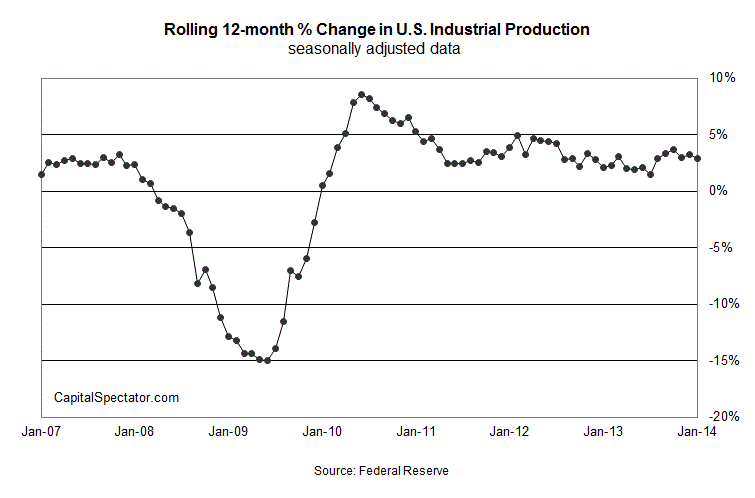Another economic report, another disappointing number. Industrial production in January slumped 0.3% from the previous month, delivering the first negative monthly comparison since last July. This is the fourth major indicator in recent weeks that’s fallen short of expectations (the latest data on personal income, nonfarm payrolls, and retail sales suffered surprisingly weak monthly changes too). The harsh winter may be the cause, in which case we’ll soon see more encouraging updates.
It’s certainly plausible (compelling?) that the weather is temporarily pinching economic activity. But there’s no way to know for sure other than to wait for more data. This much is clear: Four hefty disappointments in a row is either a genuinely dark sign for the macro trend or a one-two-three-four punch from Old Man Winter. The problem is that it’s going to take time to convincingly separate truth from fiction. That said, I’m still convinced that recession risk is low, in part because the majority of key indicators are still in the black on a year-over-year basis. Monthly data tells a different story at the moment, but monthly comparisons are generally too noisy to reveal useful signals about the state of the economy.
On that note, industrial production is still rising on an annual basis. Despite the latest batch of red ink, output is higher by 2.9% for the year through January. In fact, that’s slightly above average for the annual changes we’ve seen over the past year.
Don’t misunderstand: there’s more risk at the moment for the economy than we’ve seen in recent history, largely because of weak numbers for January that imply trouble ahead. The next major data point arrives next Wednesday with the January report on housing starts. Given recent history, it wouldn’t be surprising to see a weak update here as well.
Keep in mind, however, that until we see confirming warnings via negative annual comparisons in a range of indicators, it’s premature to make definitive judgments. Late next week I’ll publish an update of the US Economic Profile for January. Here too the numbers will suffer a bit vs. recent estimates, although not enough to send a signal that there’s a clear and present danger of falling into a new recession.
It seems that we’re destined for a run of heightened uncertainty with regards to assessing the economic trend. Indeed, the severe weather in recent weeks suggests that February data may disappoint as well. In that case, we’ll have to wait for the March data before we can convincingly evaluate the state of the business cycle and determine if there’s more than weather-related turbulence at work. Unfortunately, the March economic reports won’t see the light of day until April.
As a result, prepare yourself for a rough patch with sentiment, analysis, and the usual suspects via the media circus. We may be headed into a lengthy period of unusually vague and indeterminate economic news. Ironically, such an environment promotes radical forecasts as the crowd looks to self-proclaimed oracles who purport to know what’s coming without the benefit of hard data. Par for the course. The future’s always in doubt, and it’s likely to become more so in the weeks ahead.

Pingback: Industrial Production Contracts In January
Pingback: Friday links: learning the hard way | Abnormal Returns
Pingback: Weighing the Week Ahead: Is the Correction Over?
Pingback: A Dash of InsightWeighing the Week Ahead: Is the Correction Over? -